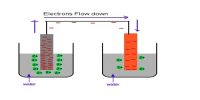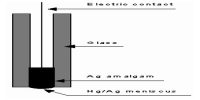Standard electrode potentials are useful in determining the strengths of any oxidising and reducing agents under standard-state conditions.
– A reduction half-reaction has the general form
oxidised species + ne– → reduced species
The oxidised species acts as an oxidising agent. Therefore the strongest oxidising agents in a table of standard electrode potentials are the oxidised species corresponding to the half-reactions with the largest (most positive) E° values. These reactions will have a strong tendency to go from left to right.
For example F2 (g):
F2 (g) + 2e– → 2F E° = 2.87V
oxidised species + ne– → reduced species
– An oxidation half-reaction has the general form
reduced species → oxidised species + ne–
The reduced species acts as a reducing agent. As standard electrode potential tables are always written with respect to reduction potentials, the strongest reducing agents in a table of standard electrode potentials are the reduced species (on the right) corresponding to the half- reactions with the smallest (most negative) E0 values.
For example Li+ (aq):
Li+ (aq) + e– → Li (s)












